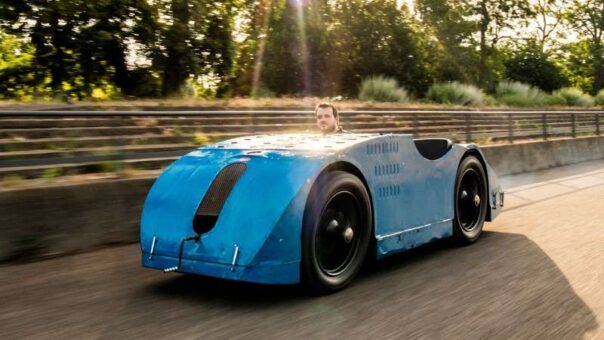Bugatti, the renowned automobile manufacturer celebrated the momentous 100th anniversary of the racing debut of its groundbreaking vehicle, the Type 32 ‘Tank’.
Revered for its visionary engineering and ingenious designs, Bugatti revolutionized motorsport with this streamlined racing car, which not only showcased its distinctive shape but also its visible rivets and bolts.
The historic event took place on 2 July 1923 at the French Grand Prix in the enchanting Loire Valley city of Tours, attracting a massive crowd of 300,000 spectators eager to witness the exhilarating race featuring cutting-edge race cars.
READ MORE: All-New Mercedes CLE Coupé: Unparalleled Luxury, Performance
Amongst the impressive lineup, the Type 32, a daring creation that exemplified the genius of Ettore Bugatti and his unwavering determination to defy conventional norms, stole the spotlight.
What instantly captivated attention was the aerodynamic design of the Type 32, inspired by the form of airplanes. Bugatti firmly believed that advanced aerodynamics would play a crucial role in enhancing racing car performance.
Although the car’s underlying structure heavily relied on the Type 30, featuring a 2.0-liter eight-cylinder engine generating approximately 90 PS, its distinctive fairing, compact wheelbase, and narrow track set it apart from its contemporaries, causing quite a stir among avid racing fans.
READ MORE: KIA Seltos Launched in India Featuring Bold Design, Unrivaled Performance
The Type 32 boasted numerous innovative engineering solutions, techniques, and designs. It featured an underslung chassis, front hydraulic brakes, and a three-speed and reverse transaxle transmission, adding an element of adventure to the car. Unsurprisingly, this unconventional vehicle, with its striking and idiosyncratic appearance, became the center of attention, standing out amidst a field of racing cars that adhered to traditional design norms prevalent at the time.
A total of five Type 32 cars were manufactured, including a prototype and the four cars that participated in the Grand Prix. The race itself proved to be a grueling challenge, involving 35 laps on a 22.83-kilometer circuit comprising public roads, amounting to a total distance of nearly 800 kilometers. Among the four participating cars, the most successful was driven by French racer Ernest Friderich, who secured an impressive third-place finish.
He completed the race in seven hours and 22.4 seconds, achieving an average speed of just over 112 km/h. While the Type 32 demonstrated commendable performance, the Grand Prix at Tours marked its sole appearance as Bugatti shifted focus to the development of the iconic Type 35. This legendary Bugatti model introduced numerous innovations, including alloy wheels, and went on to achieve phenomenal success by winning the Grand Prix World Championship in 1926.
READ MORE: Kia Introduces All-New Redesigned Picanto
Despite its brief stint in Grand Prix racing, the Type 32 proved to be a valuable endeavor for Bugatti, with its lessons learned yielding substantial rewards. Particularly, the belief in the pivotal role of aerodynamic efficiency was unequivocally demonstrated in another race car, the 57G, which earned the ‘Tank’ nickname due to its streamlined, enclosed body.
The 57G dominated endurance racing during the glorious 1930s, securing victories in the 1936 French Grand Prix and notably at Le Mans in 1937. These triumphs validated Ettore Bugatti’s visionary approach, initially realized in the Type 32 ‘Tank’ of 1923.
Even today, the Type 32 remains instantly recognizable to motorsport enthusiasts as an iconic and innovative creation by Bugatti. This masterpiece can be admired at the Musée National de l’Automobile in Mulhouse, France, and occasionally participates in thrilling action at historic races.
READ MORE: 2024 Lexus ES: Style, Tech, Performance Unleashed
